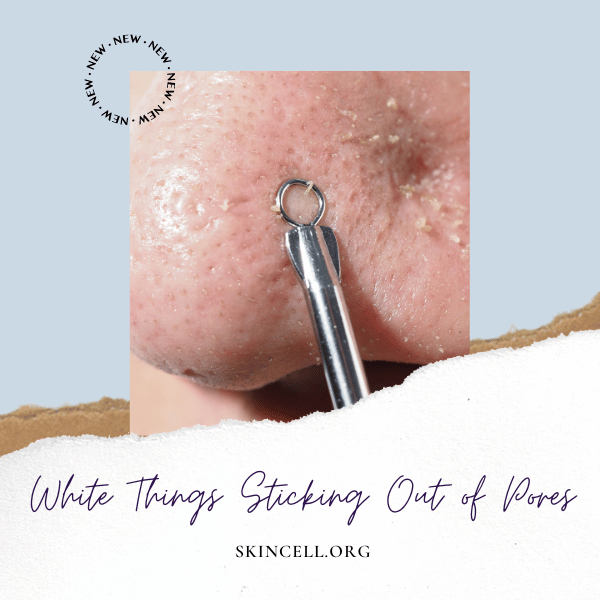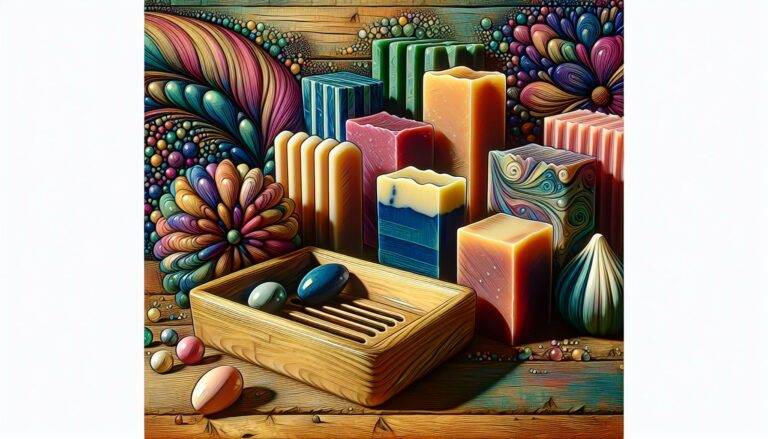White Things Sticking Out of Pores
Noticing tiny white things protruding from your pores can be puzzling.
Often, these are sebaceous filaments, a common type of pore blockage, rather than a cause for alarm. They play a role in your skin’s natural oil regulation but can become more visible and pronounced due to various factors.
Well, we’ll be going over:
- What exactly are sebaceous filaments, and how do they differ from similar skin concerns like blackheads?
- What factors contribute to the visibility and prominence of sebaceous filaments?
- How can you effectively manage and reduce the appearance of sebaceous filaments to maintain clear, healthy-looking skin?
Let’s dive in.

Understanding Skin Pores and Sebum Production
To understand what sebaceous filaments are, it’s important to first understand skin pores and sebum production. Pores are small openings on the surface of your skin that allow sweat and oil to pass through. Sebum is an oily substance that is produced by your skin’s sebaceous glands. It helps keep your skin moisturized and protected.
Common Types of Pore Blockages
Sebaceous filaments are one of several types of pore blockages that can occur. They are often confused with blackheads, which are another type of pore blockage. However, sebaceous filaments are typically lighter in color and are not as noticeable as blackheads. While they are a normal part of skin function, some people may find them unsightly and want to minimize their appearance.
Key Takeaways
- Sebaceous filaments are a common type of pore blockage that can appear as tiny white things sticking out of your pores.
- They are a normal part of skin function, but some people may want to minimize their appearance.
- Effective treatment options and preventive measures can help keep your skin looking its best.
Understanding Skin Pores and Sebum Production
If you have ever noticed white things sticking out of your pores, you might be wondering what they are and how to get rid of them. Understanding the role of sebum in skin health and the causes of these white things can help you better care for your skin.
The Role of Sebum in Skin Health
Sebum is an oily substance produced by the sebaceous glands in your skin. These glands are found all over your body, but are most concentrated on your face, scalp, chest, and back. Sebum is important for skin health because it helps to lubricate and protect your skin from damage. It also helps to keep your skin moisturized by preventing water loss.
When your body produces too much sebum, however, it can lead to oily skin and clogged pores. This can result in the formation of sebum plugs or keratin plugs, which can appear as white or yellowish bumps on your skin.
Causes of White Things in Pores
The white things that you see sticking out of your pores are likely sebum plugs or keratin plugs. These plugs form when excess sebum and dead skin cells clog your pores, preventing them from properly shedding skin cells and sebum. This can lead to the formation of small, white or yellowish bumps on your skin.
Other factors that can contribute to the formation of sebum plugs include hormonal changes, stress, and certain medications. If you have oily skin, you may be more prone to developing sebum plugs and other types of acne.
To help prevent the formation of sebum plugs, it is important to keep your skin clean and well-moisturized. You can do this by washing your face twice a day with a gentle cleanser and using a moisturizer that is appropriate for your skin type. Avoid using harsh scrubs or exfoliants, as these can irritate your skin and make the problem worse.
In summary, understanding the role of sebum in skin health and the causes of white things in pores can help you better care for your skin and prevent the formation of sebum plugs. By following a simple skincare routine and avoiding harsh products, you can keep your skin looking healthy and clear.
Common Types of Pore Blockages
When it comes to pore blockages, there are a few common types that you may encounter. Understanding what these blockages are and how they form can help you take better care of your skin.
Whiteheads and Blackheads
Whiteheads and blackheads are two of the most common types of pore blockages. They both occur when dead skin cells, bacteria, and sebum (oil) become trapped within the pores.
Whiteheads are closed comedones that appear as small, white bumps on the skin. They occur when the pore becomes clogged with oil and dead skin cells, and the opening of the pore becomes blocked. This blockage causes the oil and dead skin cells to build up, creating a small bump on the skin.
Blackheads, on the other hand, are open comedones that appear as small, black bumps on the skin. They occur when the pore becomes clogged with oil and dead skin cells, but the opening of the pore remains open. This allows air to enter the pore, which causes the oil and dead skin cells to oxidize and turn black.
Milia and Sebaceous Filaments
Milia and sebaceous filaments are two other types of pore blockages that you may encounter. Milia are small, white bumps that occur when dead skin cells become trapped beneath the surface of the skin. They are often found around the eyes and cheeks.
Sebaceous filaments, on the other hand, are small, yellowish or grayish-white threads that are often mistaken for blackheads. They occur when oil and dead skin cells become trapped within the pores, but the opening of the pore remains open. Unlike blackheads, sebaceous filaments are not caused by oxidation and do not turn black.
In order to prevent these types of pore blockages, it is important to keep your skin clean and free of dirt and oil. Regular exfoliation can also help to remove dead skin cells and prevent them from becoming trapped within the pores.
Effective Treatment Options
If you’re dealing with white things sticking out of your pores, there are various treatment options available. In this section, we’ll cover some of the most effective treatments that can help you get rid of these pesky bumps.
Topical Treatments
Topical treatments are often the first line of defense against white things sticking out of pores. These treatments can be purchased over-the-counter or prescribed by a dermatologist. Some of the most effective topical treatments include:
- Salicylic Acid: This beta-hydroxy acid is a common ingredient in many acne treatments. It works by exfoliating the skin and unclogging pores, which can help get rid of whiteheads and blackheads.
- Retinoids: These vitamin A derivatives are often used to treat acne and other skin conditions. They work by speeding up skin cell turnover and preventing the clogging of pores.
- Benzoyl Peroxide: This ingredient is commonly found in acne treatments and works by killing the bacteria that cause acne. It also helps to unclog pores and reduce inflammation.
When using topical treatments, it’s important to choose products that are noncomedogenic and nonacnegenic. These products are less likely to clog pores and cause breakouts.
Professional Dermatological Procedures
If topical treatments aren’t effective, you may want to consider professional dermatological procedures. These procedures are performed by a doctor or dermatologist and can be more effective than over-the-counter treatments. Some of the most popular dermatological procedures for white things sticking out of pores include:
- Exfoliation: This procedure involves removing the top layer of skin to help unclog pores and get rid of whiteheads and blackheads. There are various types of exfoliation, including chemical peels and microdermabrasion.
- Extraction: This procedure involves using a special tool to remove the white things sticking out of pores. It’s important to have this procedure done by a professional to avoid scarring or other damage to the skin.
Overall, there are many effective treatment options available for white things sticking out of pores. Whether you choose topical treatments or professional dermatological procedures, it’s important to work with a dermatologist to find the best treatment plan for your skin.
Preventive Measures and Skin Care Tips
Taking care of your skin is essential to prevent white things sticking out of pores. Follow a daily skin care routine that suits your skin type and make lifestyle and dietary adjustments to keep your skin healthy.
Daily Skin Care Routine
A daily skin care routine can help prevent white things from sticking out of your pores. Here are some tips:
- Cleanse your face twice a day with a gentle cleanser to remove dirt, oil, and makeup. Avoid using harsh soaps or scrubs that can irritate your skin and cause more breakouts.
- Exfoliate your skin once or twice a week to remove dead skin cells that can clog your pores. Use a gentle exfoliator that suits your skin type and avoid over-exfoliating, which can damage your skin.
- Use skin care products that are non-comedogenic and oil-free. Look for products that contain salicylic acid, benzoyl peroxide, or retinoids, which can help unclog your pores and prevent breakouts.
- Moisturize your skin daily to keep it hydrated and healthy. Choose a moisturizer that suits your skin type and is non-comedogenic.
- Protect your skin from the sun by using a broad-spectrum sunscreen with an SPF of 30 or higher. Apply sunscreen every day, even on cloudy days, and reapply every two hours if you are outdoors.
Lifestyle and Dietary Adjustments
Your lifestyle and dietary habits can also affect your skin health. Here are some tips:
- Maintain good hygiene by washing your face regularly and keeping your hands clean. Avoid touching your face too often, as it can transfer bacteria and oil to your skin.
- Avoid wearing heavy makeup or makeup that contains oils and fragrances, as it can clog your pores and cause breakouts. Choose makeup that is non-comedogenic and oil-free.
- Incorporate jojoba oil into your skin care routine, as it is similar to the natural oils produced by your skin and can help regulate oil production. Apply a few drops of jojoba oil to your face before bed and leave it on overnight.
- Eat a healthy and balanced diet that is rich in vitamins and minerals, especially vitamin A, which can help regulate oil production and prevent breakouts. Include foods such as carrots, sweet potatoes, spinach, and kale in your diet.
By following these preventive measures and skin care tips, you can keep your skin healthy and prevent white things from sticking out of your pores.
When to Consult a Professional
If you notice white things sticking out of your pores, it may be tempting to try and remove them yourself. However, there are times when it’s best to consult a professional to ensure that you receive an accurate diagnosis and appropriate treatment.
Here are some situations where you should consider seeing a dermatologist or doctor:
- If you have a large number of whiteheads or blackheads that won’t go away on their own.
- If you have tried over-the-counter treatments without success.
- If you have painful or inflamed whiteheads or blackheads.
- If you have scarring or discoloration from previous acne breakouts.
- If you have other skin concerns in addition to whiteheads or blackheads.
A dermatologist or doctor can diagnose the underlying cause of your whiteheads or blackheads and recommend a treatment plan that is tailored to your specific needs. They may suggest oral medications, topical treatments, or even surgery in some cases.
It’s important to note that attempting to remove whiteheads or blackheads yourself can lead to infection, scarring, and other complications. While it may be tempting to try and pop them, it’s best to leave it to the professionals.
In summary, if you’re experiencing whiteheads or blackheads that won’t go away or are causing you discomfort, it’s best to consult a dermatologist or doctor. They can provide an accurate diagnosis and recommend a treatment plan that is safe and effective.
Frequently Asked Questions
What are sebaceous filaments and how can they be treated?
Sebaceous filaments are tiny, cylinder-like structures that are naturally present in the skin. They are often found in the T-zone of the face, particularly on the nose. These filaments are made up of sebum, dead skin cells, and bacteria. They help to keep the skin moisturized and healthy.
While sebaceous filaments are a natural part of the skin, they can sometimes become more visible and cause concern. There are several ways to reduce their appearance, including using salicylic acid or glycolic acid-based products, getting regular facials, and using pore strips. However, it is important to note that sebaceous filaments cannot be completely eliminated.
What causes the appearance of white, worm-like structures when squeezing pores?
When you squeeze your pores, you may notice the appearance of white, worm-like structures. These structures are often mistaken for whiteheads, but they are actually sebaceous filaments. When you squeeze your pores, you are pushing the sebum and dead skin cells out of the pore, causing the filament to become visible.
It is important to note that squeezing your pores can cause damage to the skin and should be avoided. Instead, focus on using products that help to reduce the appearance of sebaceous filaments.
How can one differentiate between sebaceous filaments and blackheads?
Sebaceous filaments and blackheads can look similar, but there are some key differences. Sebaceous filaments are tiny, cylinder-like structures that are often found in the T-zone of the face. They are usually yellow or white in color and are not raised above the surface of the skin.
Blackheads, on the other hand, are raised bumps that are often black in color. They are caused by a buildup of oil and dead skin cells in the pore. Unlike sebaceous filaments, blackheads can be removed by using a comedone extractor or getting a facial.
What is the substance extracted from pimples that appears hard and white?
The substance extracted from pimples that appears hard and white is called pus. Pus is a mixture of dead skin cells, bacteria, and white blood cells. It is a sign that your body is fighting an infection.
It is important to avoid picking or squeezing pimples, as this can spread the infection and cause scarring. Instead, focus on using products that help to reduce inflammation and prevent future breakouts.
Is it harmful to manually extract sebum from pores?
Manually extracting sebum from pores can be harmful to the skin. It can cause damage to the pore and lead to scarring. It can also spread bacteria and cause inflammation.
Instead of manually extracting sebum, focus on using products that help to reduce the appearance of sebaceous filaments and prevent future breakouts.
Can sebaceous filaments appear on areas of the body other than the nose, such as the breasts?
Yes, sebaceous filaments can appear on areas of the body other than the nose. They are most commonly found on the face, particularly in the T-zone. However, they can also appear on other areas of the body, such as the breasts, back, and arms.
If you are concerned about the appearance of sebaceous filaments on other areas of your body, it is important to speak with a dermatologist. They can recommend products and treatments that can help to reduce their appearance.






